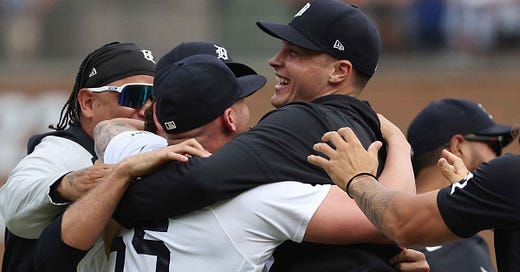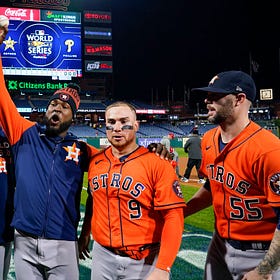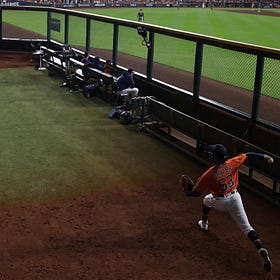There was yet another “combined no-hitter” on Saturday, this time in Detroit, where three Tigers pitchers blanked the Blue Jays over nine innings. In case you haven’t been paying attention to baseball in the last few years, a combined no-hitter is when an organization takes a no-hitter — which used to be a fun, historic accomplishment for a starting pitcher who was so locked in he pitched a whole game without allowing a hit — and ruins it by chopping it up and scattering the shards across several pitchers doing very mundane things like a starter going ~5 strong innings, or a reliever striking out the side in the 7th.
It was only the 20th combined no-hitter in the history of Major League Baseball, but the ninth since 2018. If recent history is any guide, it won’t be the last this season; there have been multiple combined no-nos every full season since 2019. There was one in the World Series last year, and I bet you already forgot about it.
Combined no-hitters are everywhere now, and they are awful. They are the result of two trends that are ruining the sport: The proliferation of relief pitchers and the decline of base hits. MLB is actively trying to reverse both of these trends with recent changes to the rules.
But more to the point, combined no-hitters are an example of how owners have sucked so much fun out of the game for the sake of efficiency. No-hitters used to be fun because they were an individual accomplishment, a test of a pitcher’s ability to work effectively deep into the game. As possible no-hitters reach about the sixth inning, fans start to feel a tension with every pitch: Can he keep going? Can he do it? It is one of the most exciting feelings in sports.
Combined no-hitters do not have that feeling. By the time fans feel that tension, the starting pitcher is pulled for a succession of relief pitchers who are doing nothing special. On Saturday, the Tigers pulled their starter in the 7th inning and brought in Jason Fraley, who didn’t give up a hit. So what? Most of his appearances this season have been hitless. Then Alex Lange pitched a scoreless ninth inning, which he has done 17 times already this year. Who cares?
The only pitcher who had a better than normal day was the starter, Matt Manning, who had given up multiple runs in all four of his previous starts. This time Manning was pretty good, going 6 ⅔ without allowing a hit. But that’s not a particularly historic line — it wasn’t even the longest scoreless start of Manning’s young career. And since teams don’t let starters finish their work anymore, he wasn’t given the chance to finish his gem: He was pulled after just 91 pitches.
This is the other awful aspect of combined no-hitters: They have ruined regular no-hitters. What used to be an exciting feeling of Can he do it? has become an anxious feeling of Will his boss let him try? Because teams are now so careful about letting starters work deep into games that fans know the biggest obstacle to finishing a no-hitter isn’t how difficult it is to do, but how reluctant teams are to LET THEM. And lest you think the Tigers were trying to preserve a pitcher’s health (Manning was injured earlier this year), they let him throw more pitches in his previous start (which was obviously NOT a no-hitter). This was all Detroit manager AJ Hinch said to explain his decision not to let Manning try for a historic accomplishment.
This is a contemptible lie. In the fifth inning, when he was supposedly “laboring a ton,” Manning retired the side on 12 pitches. In the sixth, he did it with just 8. By the seventh, when “his stuff was getting worse,” he had in fact retired 15 straight hitters. He did walk Cavan Biggio before being pulled, but he was not in danger of blowing the lead: The next batter was Whit Merrifield, who he struck out on three pitches the last time he faced him.
We should also easily dismiss the notion that “the responsibility shifts to the game,” as if the Detroit Tigers (the Tigers!) are some noble franchise dedicated to the pursuit of winning above all. The Tigers have not fielded a competitive team in seven years — they haven’t won a playoff game since the iPhone 6 came out. They aren’t going anywhere this year, as they are mired in Year Eight of a five-year rebuilding plan. This was the highlight of their season, and the reason Hinch pulled Manning was that he wanted the highlight to belong to the organization, not Manning himself.
See, Matt Manning is going to be eligible for arbitration in a couple years, and if he has a no-hitter under his belt, he might cost the Tigers slightly more than he would otherwise when it comes time to negotiate his contract.
Of course, I’m not saying that’s what was going through AJ Hinch’s mind as he pulled Manning. I’m sure he was thinking, “I’ve got some great, well-rested relief pitchers, so why take a chance?” Teams have so effectively turned their bullpens into assembly lines of cost-controlled out machines that managers just instinctively feel that going to guys like Fraley and Lange is the “right call,” even when a starter is flirting with history.
This is no fun at all. Baseball has somehow succeeded in making pitching better than it’s ever been, while also being less impressive than ever. As Marx would say, they have deskilled it.
In other words, they have taken something as fun as a no-hitter, which used to be an individual performance, crafted by a specific pitcher to fit a specific day against a specific lineup, and turned it into a bland, manufactured product that gets rolled out every few months and promptly forgotten three days later.
Whenever these games end, teammates run into each other’s arms and jump up and down like they’ve accomplished something. But whose accomplishment are we even celebrating? I suppose someone more optimistic about this trend might say it’s a team accomplishment, but that’s not really true. A no-hitter was never a team accomplishment: Many players don’t contribute at all to it, and it was always primarily a test of one guy’s ability to do something special. Something unusual and difficult and his own. That was worth celebrating. Now it’s just a bunch of guys doing their job on the same day. The celebration is just a social script, a vestige of a time when players were more than just cogs in the machine.






